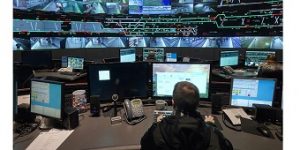
As the nerve center of an organization, a control room receives mountains of information and data from a wide variety of systems, including video, audio, access control and more to assist security operators whose duties are crucial to the safety — and the overall success — of the organization. Too often much of the focus of control room or security operations center (SOC) design is on the technology, but there are equally important factors that may seem less significant and as a result may be overlooked. Perhaps the most important of these is the people who will staff the control room. A successful design must take the operator into consideration by attempting to incorporate elements that will make them more efficient and help them do their important jobs more effectively. Let’s examine four key design considerations.
Ergonomics and Comfort
Because these individuals play such a crucial role, the control room environment must be designed with their happiness, health and productivity in mind. Comfort is a critical consideration to make, as operator discomfort can lead to distraction or neck pain from poorly thought out viewing angles and they may become distracted and miss out on critical events or emergencies.
As a result, the safety and security of the enterprise as a whole may be compromised.
That said, one of the most important elements in a control room is operators’ consoles. While it may be easy to think of these units as simply furniture, the reality is that a console is where the operator intersects with the technology they use each day. When you look at it that way, it’s easy to see how vital it is for control rooms to be designed using ergonomically correct consoles that will ensure peak physical comfort.
What makes for an ergonomic console? The answer lies in the International Standards Organization’s ISO11064 guideline, which serves as a base for determining just that.
Based on a number of factors, the two most crucial console qualities are flexibility and adjustability to allow for comfortable use by any operator throughout the course of the day, regardless of their physical characteristics. By utilizing equipment like adaptable monitor mounts, mobility and the option for an operator to either sit or stand, each operator feels as though the console was customized specifically for him or her.
Line of Sight
Given technological advances, integration with a variety of other systems and new use cases, video is at the heart of the operations for most SOCs. Today’s SOCs need a way to view a number of incoming data points, and more and more, they are turning to large-scale overview video walls to perform that function. Operators require the most complete, up-to-the-minute information regarding incoming security-related events, making uniform, integrated visual elements imperative to the overall success of an SOC or control room.
Beyond the technology that aggregates data into a single-pane-of-glass view that allows operators to quickly find and assess relevant information and respond quickly, video walls should be installed in a location that allows operators to easily see without needing to crane their necks or move into uncomfortable positions. They must also be placed in a location that doesn’t interfere with the operator’s individual workstation.
Human-Centric Lighting
Another key design consideration that often doesn’t get the attention it deserves is lighting, which can play a large role in operators’ comfort and productivity. Because no two facilities are exactly alike, lighting considerations vary widely from SOC to SOC. However, a good guideline to start with is human-centric lighting (HCL), which is the concept of adjusting lighting levels throughout the day to take the body’s circadian rhythms into consideration for operator alertness. This is particularly important for people who need to remain alert while working long evening hours.
The concept of HCL has existed for some time now but is only just now making its way into the security market. SOCs are turning to LED lighting to save energy costs and allow for dimmers and provide managers and supervisors with greater control over lighting to create HCL environments, which are easier on the eyes and on computer monitors.
Controlling Acoustics
In an SOC, operators must be able to hear and be heard to ensure safety and security, but ambient noise can interfere with their ability to perform these duties. Therefore, it is important to design control rooms with acoustics in mind to ensure the monitoring space — and even general office spaces — are as quiet as possible to maximize efficiency and productivity.
Achieving this goal means considering everything from the design of the ceiling and floor, as well as consoles and communication technologies. It might also require installing noise cancellation technology and techniques — both passive and active — to reduce, rather than reverberate, sound to eliminate unnecessary sounds that could distract operators from their vital jobs. By going beyond technology to incorporate the human element into SOC designs, integrators can make sure the operators, upon whom the success of an organization rely so heavily are happy, healthy and comfortable. The result will be increased operator efficiency and effectiveness, which allows an SOC to deliver maximum safety and security for its organization.











